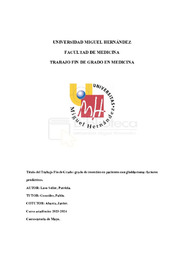Por favor, use este identificador para citar o enlazar este ítem:
https://hdl.handle.net/11000/33812Grado de resección en pacientes con glioblastoma: factores predictivos.
| Título : Grado de resección en pacientes con glioblastoma: factores predictivos. |
| Autor : Laso Seller, Patricia |
| Tutor: González López, Pablo Abarca-Olivas, javier |
| Editor : Universidad Miguel Hernández |
| Departamento: Departamentos de la UMH::Medicina Clínica |
| Fecha de publicación: 2024-04-28 |
| URI : https://hdl.handle.net/11000/33812 |
| Resumen : Introducción: El glioblastoma es el tumor primario más maligno y mortal en los adultos. Actualmente no existe un tratamiento curativo, únicamente se consigue un aumento en la supervivencia del paciente con el mejor tratamiento quirúrgico y complementarios posteriores. Debido a ello, se necesita investigación y estudios para valorar la mejor forma de conseguir una exéresis del tumor lo más amplia posible y con ello, un menor volumen residual postquirúrgico sobre el que aplicar el tratamiento oncológico. Es por esta necesidad por la cual se ha realizado este estudio, para valorar aquellos factores preoperatorios e intraoperatorios que pueden predecir o mejorar la resección de dichos tumores. Objetivos: el objetivo principal de este trabajo es analizar los factores pre e intraoperatorios que influyen en el grado de resecabilidad de glioblastomas en una serie de pacientes. El objetivo de forma secundaria es predecir de una forma aproximada qué pacientes pueden beneficiarse de una cirugía que pueda alcanzar la máxima resección posible evitando secuelas neurológicas y de esta forma aumentar la supervivencia libre de progresión, así como la supervivencia total. Material y métodos: se trata de un estudio observacional descriptivo retrospectivo que incluye una serie de pacientes operados de glioblastoma en el Hospital General Universitario Doctor Balmis de Alicante entre los periodos de 2020-2023. Se han excluido las intervenciones quirúrgicas cuyos fines no fueran de resección. La base del análisis se ha realizado mediante la medición del volumen tumoral en la resonancia magnética (RMN) protocolo T1 con gadolinio antes y después de la cirugía. Resultados: se incluyó un total de 50 pacientes. La media de edad fue de 64,18 años. Se ha obtenido un riesgo aumentado de tener mayor volumen residual postquirúrgico cuanto mayor es el volumen preoperatorio obtenido mediante la RMN, resultando este parámetro significativo. Otros parámetros que parecen presentar una tendencia a ser estadísticamente significativos son la edad y la puntuación en la escala Karnofsky. Conclusiones: En nuestro trabajo encontramos que el único factor que muestra una asociación significativa con mejorar el grado de resección en glioblastomas es tener un menor volumen tumoral preoperatorio. Existe una necesidad de seguir investigando más sobre aquellos factores que son relevantes para aumentar la resección de los tumores. Introduction: Glioblastoma is the most malignant and deadly primary tumor in adults. Currently there is no treatment that guarantees cure, only a lengthening of the patient´s survival is achieved with surgical treatment. Due to this, research and studies are needed to assess the best way to achieve a complete excision or the tumor and, therefore, a lower post-surgical residual volume. It is for this need that this study has been carried out, to assess those preoperative and intraoperative factors that can predict or improve the resection of said tumors. Objectives: the main objective is to analyze the pre- and intraoperative factors that influence the degree of resectability of glioblastomas in a series of patients. The secondary objective is to approximately predict which patients can benefit from a surgery that can achieve the maximum possible resection, avoiding neurological sequelae and thus increasing progression-free survival, as well as overall survival. Material and methods: this is a retrospective descriptive observational study that includes a series of patients operated on for glioblastoma at the Doctor Balmis General Hospital in Alicante between the periods of 2020-2023. Surgical interventions whose purposes were not resection have been excluded. The basis of the analysis was performed by measuring tumor volume on T1 protocol magnetic resonance imaging (MRI) with gadolinium before and after surgery. Results: a total of 50 patients were included. The average age was 64.18 years. An increased risk of having a greater postsurgical residual volume has been obtained the greater the preoperative volume obtained through MRI, this parameter being significant. Other parameters that seem to show a tendency to be statistically significant are age and the Karnofsky scale. Conclusions: In our work we found that the only factor that shows a significant association with improving the degree of resection in glioblastomas is having a lower preoperative tumor volume. There is a need for further research into those factors that are relevant to increasing tumor resection. |
| Palabras clave/Materias: Glioblastoma (GM) grado de resecabilidad (EOR) volumen residual Karnofsky |
| Área de conocimiento : CDU: Ciencias aplicadas: Medicina |
| Tipo de documento : info:eu-repo/semantics/bachelorThesis |
| Derechos de acceso: info:eu-repo/semantics/openAccess |
| Aparece en las colecciones: TFG- Medicina |
 La licencia se describe como: Atribución-NonComercial-NoDerivada 4.0 Internacional.
La licencia se describe como: Atribución-NonComercial-NoDerivada 4.0 Internacional.
.png)
